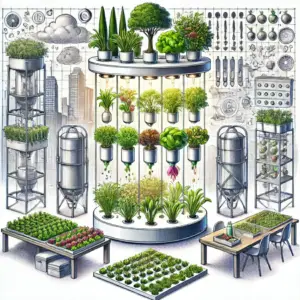
Are you curious about the latest advancements in sustainable agriculture?
Aeroponics might just be the innovative solution you’ve been looking for.
This cutting-edge technique allows plants to grow without soil, offering numerous benefits for both small-scale urban gardeners and large commercial farms.
In this article, we’ll explore what aeroponics is, how it works, its advantages, and its applications in modern agriculture.
Understanding Aeroponics
Definition of Aeroponics
Aeroponics is a method of growing plants where the roots are suspended in the air and misted with a nutrient-rich solution.
Unlike traditional soil-based methods or even hydroponics, aeroponics does not require any growing medium.
This soil-less technique allows for optimal oxygenation of the roots, leading to faster growth and higher yields.
How Aeroponics Works
In an aeroponic system, plants are anchored in a framework that keeps their roots exposed to the air.
The roots are periodically misted with a fine spray containing water and essential nutrients.
This misting process ensures that the plants receive the necessary hydration and nutrients for growth.
The lack of soil means that plants can grow with less water and space, making aeroponics an efficient and sustainable method.
Advantages of Aeroponics
Faster Plant Growth
One of the primary benefits of aeroponics is the accelerated growth rate.
Since the roots have constant access to oxygen and nutrients, plants can grow up to twice as fast as they would in soil.
This rapid growth can result in quicker harvests and increased productivity.
Efficient Use of Resources
Aeroponics uses significantly less water than traditional farming methods.
The nutrient solution is recycled through the system, reducing waste and conserving water.
This efficiency makes aeroponics ideal for regions with limited water resources or for urban farming where space and resources are at a premium.
Better Plant Health
By eliminating soil, aeroponics reduces the risk of soil-borne diseases and pests.
The controlled environment also allows for precise regulation of nutrient levels and pH, ensuring optimal plant health.
Healthier plants are more resistant to diseases and produce higher yields.
Space-Saving Design
Aeroponic systems can be designed vertically, making them perfect for urban environments where space is limited.
Vertical farming setups can maximize production in small areas, such as rooftops or indoor spaces, contributing to the growth of urban agriculture.
Applications of Aeroponics
Commercial Agriculture
Large-scale farms can benefit from the efficiency and high yields of aeroponics.
Crops like leafy greens, herbs, and strawberries are commonly grown using this method.
The ability to produce more in less time and with fewer resources makes aeroponics an attractive option for commercial growers.
Urban and Vertical Farming
In urban areas, where space is at a premium, aeroponics offers a viable solution for local food production.
Vertical farming setups using aeroponics can transform underutilized spaces into productive gardens.
This not only provides fresh produce to urban populations but also reduces the carbon footprint associated with transporting food.
Research and Education
Aeroponics is also valuable in scientific research and educational settings.
Researchers can study root growth and plant health in a controlled environment, leading to advancements in agricultural science.
Educational institutions use aeroponic systems to teach students about sustainable farming practices and plant biology.
Getting Started with Aeroponics
Choosing an Aeroponic System
Several aeroponic systems are available, ranging from small home kits to large commercial setups.
When selecting a system, consider the space you have available, the types of plants you want to grow, and your budget.
For those new to aeroponics, starting with a simple, easy-to-use system like the Lettuce Grow Farmstand can be a great option.
Setting Up Your Aeroponic Garden
-
Location: Choose a location with adequate light and access to water. Indoor setups may require grow lights to ensure plants receive enough light. A versatile system like the GrowAce Grow Tent Kit can help you create the perfect growing environment.
-
Assembly: Follow the manufacturer’s instructions to assemble your aeroponic system. Ensure all components are properly connected and secure.
-
Nutrient Solution: Prepare the nutrient solution according to the instructions. Fill the reservoir and connect it to the misting system.
-
Planting: Insert seedlings or cuttings into the system. Ensure that the roots are exposed to the mist and that the plants are securely anchored.
Maintenance Tips
-
Monitor: Regularly check the nutrient levels, pH, and water levels in the reservoir. Adjust as needed to maintain optimal conditions. Using a reliable filtration system like NuAqua Systems can help ensure your plants receive clean, nutrient-rich water.
-
Clean: Clean the system periodically to prevent buildup of algae or nutrient deposits. This will help keep your plants healthy and the system running efficiently.
-
Inspect: Regularly inspect your plants for signs of disease or pests. Early detection and intervention can prevent problems from spreading.
The Future of Aeroponics
Aeroponics represents a significant advancement in agricultural technology.
As the global population continues to grow and urbanize, the demand for efficient, sustainable farming methods will only increase.
Aeroponics offers a promising solution, providing high yields with minimal resources.
Continued innovation and investment in this technology will likely lead to even more efficient and accessible aeroponic systems in the future.
Embracing the Future of Farming
Aeroponics is an exciting and innovative method of growing plants that offers numerous benefits over traditional soil-based farming.
With its efficient use of water and space, faster growth rates, and healthier plants, aeroponics is poised to play a significant role in the future of sustainable agriculture.
Whether you’re a commercial grower, urban farmer, or hobbyist, aeroponics provides a versatile and effective way to cultivate a wide variety of plants.
Explore the possibilities of aeroponics and take a step towards a more sustainable and productive future in farming.
